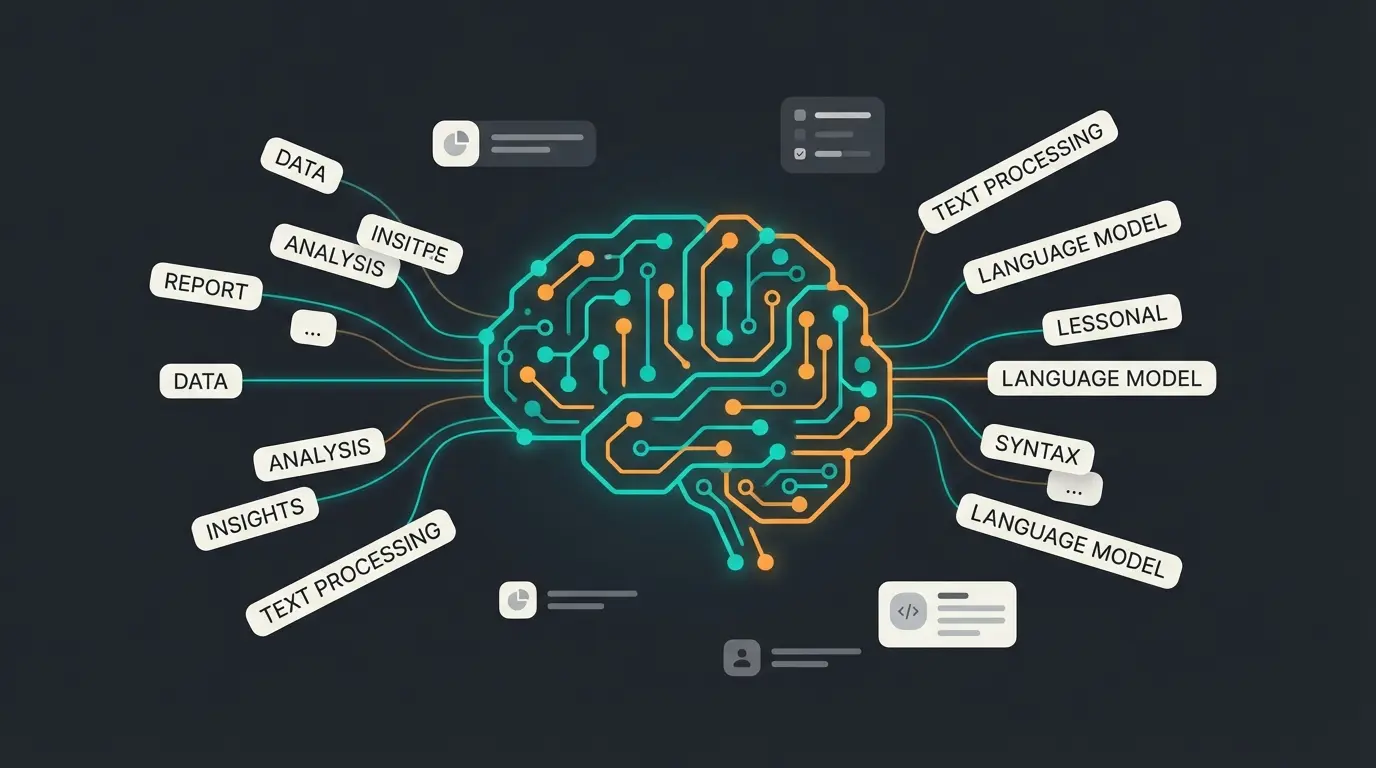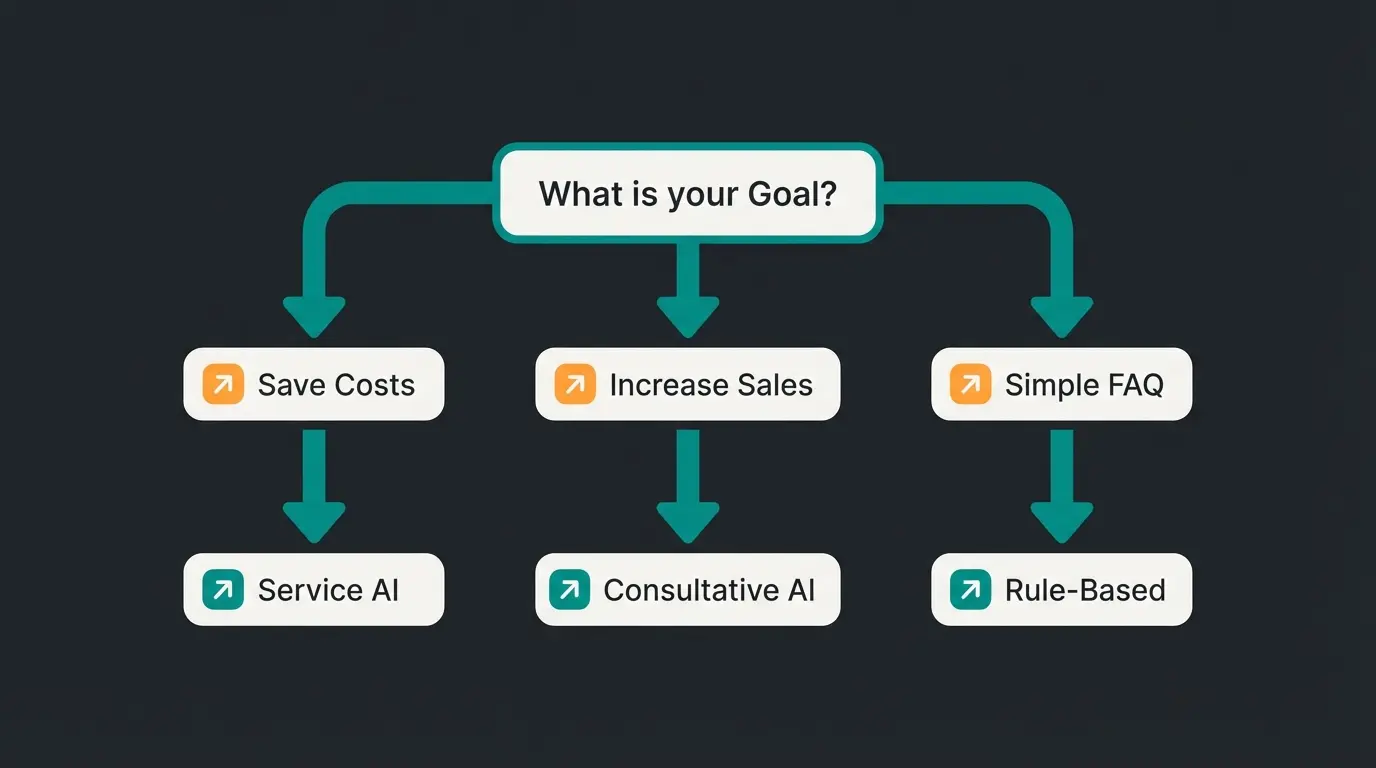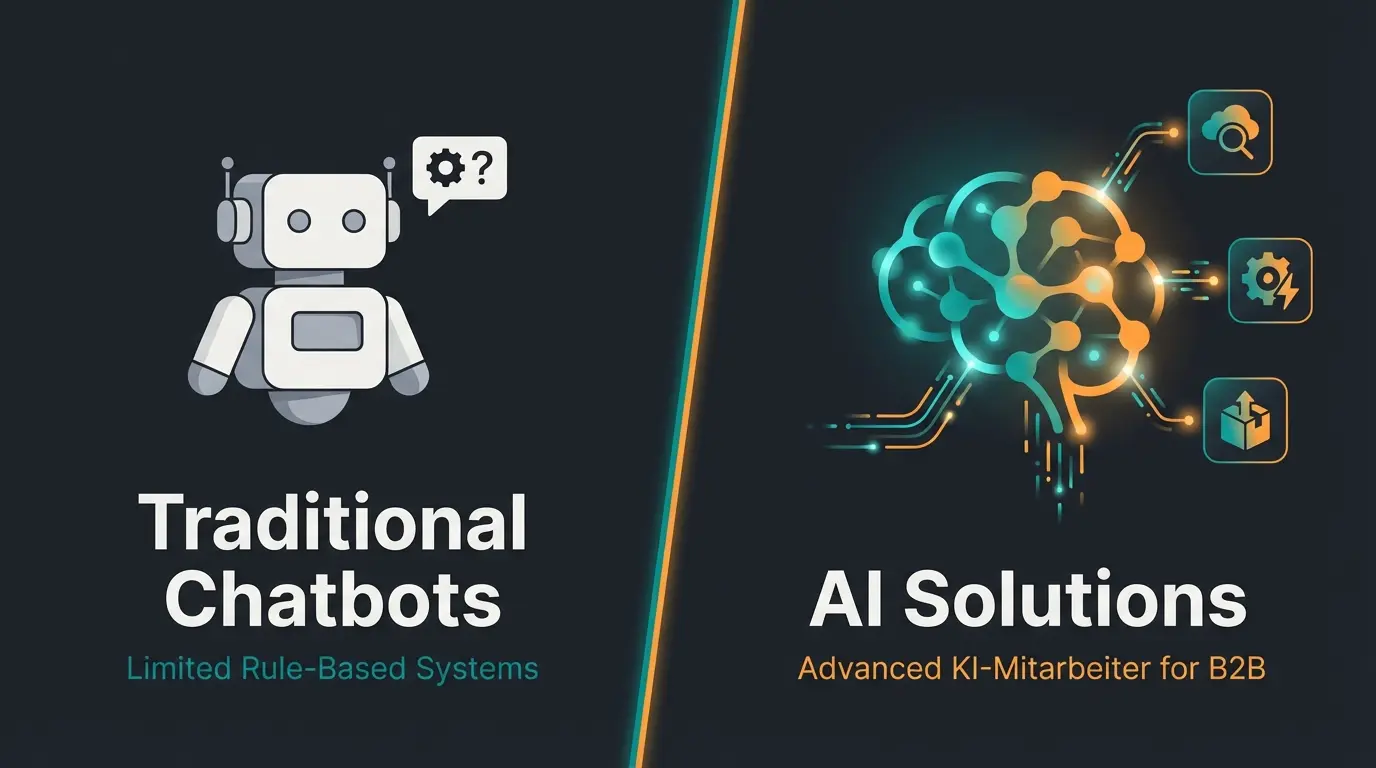In today's digital landscape, modern chatbot solutions have become indispensable tools for businesses and consumers alike. These intelligent software programs simulate human conversations and offer a variety of services – from customer support to product advice. Chatbots work by analyzing user input and generating appropriate responses based on that input.
For businesses, chatbots offer enormous advantages: they enable 24/7 availability, reduce personnel costs, and increase the efficiency of customer interaction. Consumers benefit from quick answers, personalized recommendations, and straightforward solutions to their concerns.
The world of chatbots is diverse and encompasses different types that differ in their functionality, capabilities and areas of application. From simple rule-based systems to highly developed AI-powered solutions – each chatbot type has its specific strengths and areas of application.
The 3 classic chatbot types (and their limits)
In the field of chatbot technology, there are traditionally two main categories, which are often supplemented by hybrid models: rule-based and AI-powered chatbots. Both types have their own characteristics, advantages and disadvantages, as well as specific areas of application.
1. Rule-based chatbots: Functionality and areas of application
Rule-based chatbots, also known as decision tree-based chatbots, follow a predefined script or a set of "If-Then" rules. They work like a decision tree, where each user response leads to a specific pre-programmed reaction.
This type of chatbot is particularly well suited for:
- Customer service: Answering frequently asked questions (FAQs)
- Ordering processes: Guiding through simple, structured processes
- Appointment scheduling: Booking appointments according to predefined criteria
Rule-based chatbots are relatively easy to implement and maintain. They offer predictable, consistent answers, which can be advantageous in many business situations. However, they are severely limited in their flexibility and can only react to pre-defined scenarios. As soon as a user asks a question that is not in the script, the bot fails.
2. AI-powered chatbots: Machine learning and NLP

In contrast, AI-powered chatbots use advanced technologies such as machine learning and natural language processing (NLP). These chatbots can understand natural language, grasp context, and learn from interactions to continuously improve their responses.
AI chatbots are characterized by the following features:
- Adaptability: Adapting to different conversation flows
- Contextual understanding: Grasping nuances and connections (e.g. sarcasm or slang)
- Learnability: Continuous improvement through interactions
These chatbots are particularly suitable for complex tasks such as personalized product recommendations, detailed customer advice, or handling complaints. They can revolutionize customer interaction by conducting human-like conversations and responding to subtle nuances.
3. Hybrid Models: Combining the Strengths
In practice, many companies rely on hybrid solutions that combine the advantages of both chatbot types. These combined systems can both efficiently perform specific tasks and conduct natural conversations. Often the bot takes over the pre-qualification and seamlessly hands over to a human employee in the case of complex problems.
An example of a successful hybrid approach is the AI employee Flora von Neudorff, which was developed in cooperation with Qualimero AI platform. Flora not only offers precise product recommendations, but also conducts natural conversations with customers about garden care and plant health.
Rigid, menu-driven, only reacts to keywords.
Understands intentions (intents), good for FAQs.
Generative, proactive, advises like a salesperson.
The new generation: Generative AI and "Consultative Chatbots"
Most market overviews end with the distinction between rule-based and AI. However, the breakthrough of Large Language Models (LLMs) has created a completely new category that is crucial for e-commerce and sales: Consultative AI.
While classic AI bots are trained to answer a question as quickly as possible (close the ticket), a Consultative AI is trained to conduct a sales conversation. It does not act passively, but proactively.
The difference lies in the dialogue flow:
- Standard Bot: Customer asks "I need running shoes." -> Bot replies: "Here is the link to our running shoe category."
- Consultative AI: Customer asks "I need running shoes." -> Bot asks back: "Sure! Do you run more on asphalt or in the forest? And do you have any stability issues?"
This ability to ask follow-up questions and analyze needs makes this type of chatbot a Digital Product Advisor. It does not aim at efficiency (saving time), but at effectiveness (increasing sales and conversion rate).
Big Comparison: Rule-Based vs. Service AI vs. Consulting AI
To make the right decision for your company, a direct comparison of the three dominant technologies helps.
| Criterion | Rule-Based Bot | Classic Service AI | Consultative AI (GenAI) |
|---|---|---|---|
| Technology | Decision Tree (If-Then) | NLP / Intent Recognition | LLM / Generative AI |
| Main Goal | Navigation & Filtering | Reduce Support Tickets | Increase Revenue & Conversion |
| Interaction | Click-based (Buttons) | Reactive (Answer to Question) | Proactive (Consultation) |
| Flexibility | Low (Rigid) | Medium (Trained Intents) | High (Understands any Context) |
| Setup Time | Low | Medium to High | Medium (Prompt Engineering) |
Task-oriented vs. conversational chatbots
In addition to the technological distinction, the consideration of task orientation is also important. These categories represent different approaches in the interaction between humans and machines.
Task-oriented chatbots: Efficient problem solvers
Task-oriented chatbots are designed to efficiently perform specific tasks. They function like digital assistants that are focused on specific requests or problems. Their strength lies in the quick and precise processing of clearly defined tasks.
Typical areas of application for task-oriented chatbots are:
- Customer service: Answering frequently asked questions
- Ordering processes: Support with product selection and order processing
- Appointment scheduling: Automated booking of appointments
This type of chatbot is particularly suitable for companies that want to automate certain processes and increase their efficiency. They offer clear, goal-oriented interactions and can take over a variety of routine tasks.
Conversational Chatbots: Natural Communication
In contrast, conversational chatbots are designed to conduct human-like conversations. They use advanced Conversational AI technologies to enable natural dialogues. These chatbots understand the context of a conversation and can flexibly respond to various topics.
Conversational chatbots are characterized by:
- Contextual understanding: They keep track of the conversation
- Emotional intelligence: Recognition and appropriate response to moods
- Learnability: Continuous improvement through interactions
These chatbots are used in areas where a more personal and natural communication is desired, such as in customer support or brand interaction.
Whether it's a simple service bot or a high-revenue Consultative AI – we analyze your needs and find the perfect solution.
Arrange a free initial consultationIndustry-Specific Chatbots
The diversity of chatbot types is particularly evident in their industry-specific application. Different economic sectors have different requirements for their digital assistants, which leads to specialized solutions.
E-Commerce Chatbots: Virtual Sales Consultants
In the e-commerce sector, chatbots act as virtual sales consultants who support the entire purchasing process. They offer personalized product recommendations, answer questions about articles and assist with the purchase process.
According to a forecast by Juniper Research, retail sales via chatbots will rise to $142 billion by 2024. This underlines the growing importance of chatbots in the e-commerce sector.
Functions of e-commerce chatbots include:
- Product search: Support in finding suitable articles
- Consultation: Answering questions about product features
- Purchase completion: Accompaniment through the ordering process
Finance Chatbots: Digital Bank Advisors and Financial Assistants
In the financial sector, chatbots take on the role of digital bank advisors and financial assistants. They offer support with banking transactions, provide information on account movements and help with financial planning.
Finance chatbots are characterized by:
- Account management: Overview of account balances and transactions
- Financial advice: Basic tips on investment and budget planning
- Security: High data protection and security standards
Health Chatbots: Initial Medical Advice and Patient Care
In healthcare, chatbots support initial medical advice and patient care. They can query symptoms, provide general health information, and remind you of appointments or medication intake.
Platform-Specific Chatbots
In the diverse world of chatbots, platform-specific solutions play a central role. These chatbots are specially developed and optimized for specific communication channels. They fit seamlessly into the respective environment and offer users an intuitive interaction option.
Website Chatbots: Direct Customer Support
Website chatbots are often the first point of contact between companies and potential customers. They usually appear as small chat windows on the website and offer immediate help with questions or problems. This type of chatbot can provide product information, schedule appointments, and navigate visitors through the website.
Website chatbots can be rule-based as well as AI-powered. AI-powered variants often offer a more natural conversation and can handle more complex requests.
Messaging App Chatbots: Integration into WhatsApp & Co.
With the increasing popularity of messaging apps, chatbots for these platforms have become an important communication channel. They allow companies to reach customers where they already are. Integration into popular apps such as WhatsApp or Facebook Messenger significantly increases the reach and accessibility of chatbots. Users do not have to download an additional app, which lowers the entry barrier.
Advantages and Disadvantages of Different Chatbot Types
When choosing the right chatbot type for a company, it is important to know the specific advantages and disadvantages of each variant. Careful consideration helps to find the optimal solution for individual requirements.
- Rule-based chatbots deliver precise answers to predefined questions, but are limited in their flexibility.
- AI-powered chatbots can understand and process more complex requests, but often require more training and fine-tuning.
- Hybrid systems combine the strengths of both approaches for optimal results.
The choice depends heavily on the area of application and the desired depth of interaction. For simple tasks such as querying opening hours, a rule-based chatbot is often sufficient, while an AI-powered assistant may be more useful for comprehensive product advice.
Implementation effort and costs
The effort for implementation and maintenance differs depending on the chatbot type. Rule-based systems are often quicker to set up, but require regular manual updates of the rules. AI chatbots require a longer setup and training phase, but can continuously improve and adapt.
Decision support: Which chatbot fits your goal?

To make the selection easier, we have developed a simple decision logic based on your primary business goal:
Do you have a high ticket volume with the same questions? -> Choose classic service AI or rule-based bots.
Do you just want to collect contact details for a callback? -> A simple rule-based bot is often sufficient.
Do you have products that require explanation and want to sell online? -> You absolutely need a Consultative AI.
By carefully considering these factors, you can choose the chatbot type that best suits your business needs. Further information on how AI chatbots work can be found in our detailed guide.
Future Trends in Chatbot Types
The development of chatbots is progressing rapidly. New technologies and innovations are constantly expanding the possibilities of these digital assistants. Future chatbots will not only be limited to text. The integration of voice and image recognition opens up new dimensions of interaction.
The next generation of chatbots will also be able to recognize emotions and react appropriately. The continuous development of AI technology will make chatbots even more powerful. Further insights into the evolution of chatbots can be found in our detailed article on this topic.
The University of Bamberg offers a course on advanced dialogue systems and Conversational AI that delves deeper into the technical aspects of these developments.
Conclusion: Why the Future Belongs to "Consultative AI"
The variety of chatbot types opens up numerous opportunities for companies. While rule-based systems retain their place for simple tasks, the focus in the competition is clearly shifting towards AI-powered chatbots and in particular towards "Consultative AI".
Anyone who still relies exclusively on rigid click-bots today risks losing customers to competitors who offer a real, consultative experience. A well-designed product advisor bot can not only reduce support costs, but also actively become a sales driver.
The three main types are rule-based chatbots (click-bots), classic AI chatbots (service AI for support) and modern Consultative AI (generative AI for product consulting).
A Consultative AI is best suited for e-commerce. It acts as a digital salesperson, asks follow-up questions about needs and actively recommends products, which increases the conversion rate.
Initially, the costs may be higher, but modern LLM-based bots often amortize faster due to saved personnel costs and increased sales. Simple rule-bots are inexpensive to set up, but expensive to maintain if processes change.
A chatbot is the program itself. Conversational AI is the technology behind it (NLP, Machine Learning) that allows the bot to understand natural language and not just respond to commands.
Start now with a Consultative AI that not only answers questions, but actively sells.
Request a demo now
